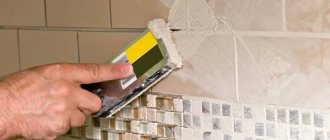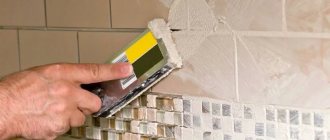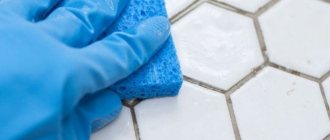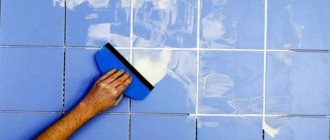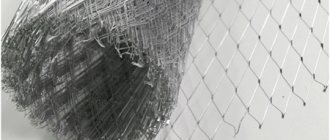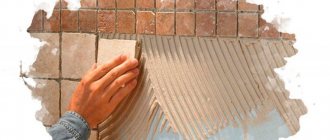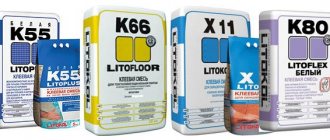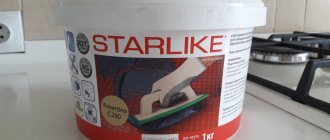Specifications
The Litokol brand grout mixture is a special epoxy, cement or polyurethane material that seals the seams between the tile elements, sealing the surface from moisture and various dirt. Available in a wide range of colors to match many types of tiles and porcelain stoneware.
The joint sealer has the following characteristics:
- low abrasion coefficient;
- used at temperatures not lower than -20 degrees;
- when frozen, withstands temperatures up to +100 degrees;
- not prone to mechanical stress by compression and bending;
- is resistant to UV rays;
- due to the presence of shiny components (in some types and epoxy), it additionally decorates the surface;
- After hardening, it withstands acidic and alkaline environments.
Cement or epoxy grout - comparison of properties
Which grout to choose—cement or epoxy—everyone decides for himself, taking into account the material he will be working with and the operating conditions.
| Cement mixture | Epoxy mixture |
| This is a classic composition based on finely ground cement, pigments, additives and plasticizers, which is brought into working condition by adding water to the dry mixture. Sometimes water-based latex is used. | Due to the content of additives, quartz sand and hardener in the epoxy resin, the strength of such a mixture is higher. In the process of preparing a dense, elastic working solution, epoxy resin is mixed with a hardener. |
| The solution is easy to use, and even without skill you can get an excellent result. | To work with such a composition, certain skills are required, since the finished solution is more viscous, and working with it is more difficult and longer. |
| To work with wide seams, sand is added to the traditional composition, and the wider the seam, the larger the sand granules should be. | Epoxy grout is best used where cement mortar cannot cope with its tasks in difficult operating conditions - in a swimming pool, laboratory, on a kitchen apron and worktop, which are exposed to grease, moisture and dirt. |
| The material is sold in the form of a dry mixture or a ready-to-use solution. The latter cannot be stored after opening the package and must be used immediately. | This grout is not afraid of exposure to chemicals, fungus or mold, it is durable and has a high decorative effect due to the addition of glitter. The brightness of the color lasts for decades. |
| Remove from the surface of the tile using a damp foam float. | |
| Powder cement grout is advantageous to purchase for large volumes of work. | It is necessary to remove excess from the tile surface within 24 hours; it will not be possible to do this later. To remove the frozen mixture, use a special remover, which can be purchased at a hardware store. |
| The cost of the material is low, it is easy to choose a shade to match any color of the tile, since the range is quite wide. | |
| When exposed to household chemicals and pollution, such grout is destroyed over time. | Disadvantages include the high cost of the material and the difficulty of working with it. |
Cement grout mixture is produced in dry form and packaged in bags
Advantages of brand products
Based on the characteristics presented above, the features of this material include and highlight resistance to various adverse environments and numerous physical influences.
Therefore, Litokol has been widely used when finishing various rooms, from the bathroom, shower room to kitchens and living rooms. Epoxy-based grouts acquire a characteristic shine, which allows you to highlight the facing coating in an original way with a beautiful frame.
Another special feature is that it easily fills thin joints with a thickness of only 0.5 mm. To work, you will need a special rubber spatula with sufficient flexibility and moderate rigidity.
Reliability and resistance to damage and ultraviolet rays are also strengths of the brand's products. Thanks to the use of Litokol grout, you can delay the next repair, because the seams between the tiles will retain their original color after a very long time.
The best manufacturers of tile grout - which company to choose
If you want to be sure of the reliability and durability of the grout, give preference to well-known brands with a good reputation. They strictly follow the recipe and use high-quality ingredients for their mixtures.
So if your goal is to make repairs once and never think about it again for many years, do not spare money on products from reputable manufacturers:
- Ceresit;
- Litokol;
- Mapei;
- Sopro.
The range of grouts from these companies is quite wide, so it will not be difficult to choose a tile grout that is suitable for the characteristics and color. You can find the best products in this review, and our article will help you decide on a specific type of grout.
Recommendations:
Flow calculation
To make the correct calculation of the grouting composition, take into account the width and depth of the seam. Size is also a mandatory element. Whatever tool you use for this, you should make a reserve for losses of at least 5%, especially if the work will be performed by an inexperienced craftsman.
In practice, with a seam width of 1.5-2 mm per area of 17 square meters. m and with a tile size of 18x60 cm, about 2 kg of product will be required. However, it will not be possible to accurately calculate, since the size of the voids under the tiles varies. In addition, as the size of the tile decreases, the volume of Litokol for sealing joints increases, for example, in the case of mosaics.
The principle of calculating the flow rate is based on calculating the total volume of voids between the cladding elements; this will require the following data:
- the type of grout, or rather its density, is taken as 1.8 by default;
- product format;
- seam width;
- room area.
The weight of the grout is determined as the product of the volume of voids and the density of the substance. Also use special reference tables for tiles with standard sizes. The amount of consumption is also affected by how the seam was prepared and whether the glue was removed from it.
Comparative table of grout consumption rates from different manufacturers, kg/m2
The grout consumption table for tiles looks like this:
| Length, width and thickness of tiles (centimeters) | Grout brand | Approximate grout consumption rate (kg per meter2) |
| 10 x 10 x 0.6 | Ceresit | 0,21 |
| Litokol | 0,19 | |
| Mapel | 0,18 | |
| 20 x 20 x 0.8 | Ceresit | 0,14 |
| Litokol | 0,12 | |
| Mapel | 0,13 | |
| 30 x 30 x 0.6 | Ceresit | 0,07 |
| Litokol | 0,06 | |
| Mapel | 0,07 | |
| 40 x 40 x 0.8 | Ceresit | 0,07 |
| Litokol | 0,06 | |
| Mapel | 0,07 | |
| 60 x 60 x 1 | Ceresit | 0,06 |
| Litokol | 0,05 | |
| Mapel | 0,06 |
Please note that the table shows grout consumption rates for sealing a 1 mm thick seam . If you are dealing with a thicker seam, then you need to multiply the corresponding number from the table by the thickness value.
For example, you want to seal a 3 millimeter thick seam using a Ceresit mixture, where the tile parameters are 20 x 20 x 0.8 centimeters.
The tile grout consumption table states that the consumption rate in this case is 0.14 kg. Since the layer thickness is 3 millimeters, you need to multiply 0.14 by 3, which will be equal to 0.52. That is, the grout consumption in this case will be 0.52 kg per square meter of wall.
Do you think Litokol grout is economical?
Not really
Calculator for calculating the amount of grout Litokol
Tips for using materials
Let's give some tips on using grout:
- Grout CE 33 is used for joint widths less than 5 mm , CE 35 - for joint widths from 4 to 15 mm , CE 40 with 32 color options is suitable if the joint size is 10 mm . Grouts CS 25 and CE 79 are an excellent choice if you plan to close a joint from 5 to 30 mm .
- Grouts CE 33 and CE 35 CT 10 for external use . Mark CE 40 is designed specifically for fixing cladding consisting of natural marble tiles.
- CS 25 composition on a silicone rubber base is required for grouting planes and surfaces that allow some movement relative to each other - expansion joints, corners, places where they interface with the lining of sanitary equipment: sinks, toilets, bathtubs and showers.
- The two-component epoxy compound CE 79 is needed for grouting cladding joints that are subject to long-term or cyclic loads. For example, tiled floors in public places - shops, cinemas, entrances of multi-storey buildings. Sometimes this composition is also used as a tile adhesive.
Work on grouting tile joints should be carried out at a minimum daily ambient temperature of at least 5 degrees Celsius.
Typically, the joints should be dry, except when using tiles with a high coefficient of water absorption, in which case the joints must first be moistened with water.
Varieties
Several types of grouting compounds are produced under the Litokol brand. Each of them is used in certain cases. For example, if the tile is matte, then highlighting it with shine is completely impractical. It is better to use a suitable cement-based grout.
If the tile is glossy, with a bright pattern and shiny fragments, then use an epoxy-based joint sealing material. In general, the brand produces the following types of mixtures depending on the base:
- cement;
- epoxy;
- polyurethane.
Each of the presented types has advantages and features that determine their use in a particular case.
Cement mixtures
Cement-based products are universal materials used for sealing joints in tile or porcelain stoneware cladding. They have increased resistance to various adverse factors, therefore they are used both for interior work and for exterior decoration.
Cement is also resistant to abrasion and the negative effects of UV radiation. Seals the seam, preventing moisture from entering under the masonry. After the cladding surface has dried, characteristic grayish-whitish stains remain. They must be gotten rid of immediately after they appear.
Epoxy grouts
Epoxy grout produced by Litokol is a special composition for sealing joints between elements for wall and floor cladding. Its peculiarity is that without the addition of auxiliary components it has an attractive shine. This will undoubtedly make your decoration more aesthetically pleasing and attractive.
But there is a small disadvantage, which is the high cost. It is much more expensive than cement-based materials.
Epoxy resins, which are the basis of the grout, withstand the effects of any chemical and biological substances, so the finish will remain flawless for a long service life. It is ideal for all types of rooms and surfaces.
It holds together perfectly, literally forming a single whole. Also widely used on kitchen work surfaces. Has low abrasion.
On our website you can also read about epoxy grout Litokol
Polyurethane grout
To carry out finishing repairs in premises, it is necessary to choose the right materials for this. For example, to seal seams between tiles up to 6 mm thick, while the facing coating is glass mosaic, it is better to use polyurethane grout.
They will better protect the finish from moisture due to the properties of the resins contained in their composition. They are resistant to sunlight, but can only be used in the temperature range from -15 to +80 degrees. That is, the use of such material for outdoor work is not recommended. Surfaces are easier to clean after sealing.
Types of mixtures and release forms
The range of products manufactured under the Litokol brand is extensive and varied. The manufacturer supplies the construction market with cement-based and epoxy-based grouting mixtures, latex additives, plasters, self-leveling mixtures, adhesives and other products. For different types of finishing work, the Litokol company produces several types of epoxy grout:
- The colorless mixture Starlike C. 350 Crystal Litokol is used for grouting joints between glass fragments made of decorative smalt when making mosaic panels and artistic compositions. The paste has a “chameleon” effect - after application it takes on the color of the facing tile. The minimum consumption of litochrom starlike epoxy grout is 0.93 kg/m2.
2. Translucent grout Starlike Color Crystal Litocol is used for mosaic finishing, reproducing the original shades of the facing material. It is highly resistant to aggressive environments. In compositions it creates a pleasant visual effect, “adjusting” to the colors of the cladding. The prepared solution must be applied immediately - drying time is 60 minutes.
3. Antibacterial grout mixture for Starlike Defender ceramics has improved antiseptic properties and good resistance to acids. The main area of application is filling joints (1-15 mm) between ceramic tiles. Can be used on surfaces in contact with food.
4. Epoxystuk X90 grout has increased moisture resistance, therefore it is most often used for tiling bathrooms, kitchens, and swimming pools. The paste is presented in a wide palette of shades - more than a hundred interesting colors of Litokol Epoxystuk X90 grout. The composition can be used on horizontal and vertical planes.
5. Decorative grout Litochrome Starlike is a durable universal material for sealing tile joints from 1 to 15 mm. Suitable for indoor and outdoor use, has zero runoff on vertical surfaces. Pigment substances of various shades are introduced into the composition of the grout. The advantages of the mixture are high strength and dense filling of joints.
The manufacturer produces special additives that have an unusual optical effect. STARLIKE FINISHES is used for mixing with epoxy grouts. As a result, the tile seams acquire pearlescent, shiny, gold, bronze, copper and luminescent shades. Thanks to the introduction of additives, the compositions are accentuated, rich and bright.
On video: Litochrom LUXURY grout mixture
Instructions for use
To seal the joints between tiles, it is recommended to purchase a standard set of tools and accessories. It is suitable for all types of grout, but will wear out to varying degrees, which also largely depends on the type of tile laid.
To make working with the mixture comfortable, purchase the following tools in advance:
- Special sponge made of cellulose with soft and rough sides. Take several of them; if the treatment area is large, it will wear out quickly enough.
- A bucket for rinsing the sponge is called a skipper. It is equipped with rollers, thanks to which the spinning process is greatly simplified.
- To effectively remove residues on cladding, it is recommended to use a grater with a cellulose attachment.
Mixing the mixture
After everything has been purchased and the work area has been prepared, start mixing the composition. Polyurethane is sold ready-made, so you just start filling the seams with it. Epoxy putty must be prepared by mixing two components. They are sold as a set.
Of these, A is the epoxy resin itself, B is a substance that accelerates the hardening process of the composition. You need to work with her quickly, just like with everyone else. To prepare, add water and stir to form a paste. It is important not to overdo it so that it is comfortable to work with the material.
Filling and shaping the seam
After the putty has acquired a paste-like state, proceed to sealing the seams. This should be done from the corner of the room, so as not to trample on the freshly treated surface. Using a rubber spatula, apply a small amount of solution to the area to be treated.
Then, using a sponge, smooth it over all the seams, thoroughly rubbing it into them and at the same time removing excess, often washing it in water. All types of grout must be smoothed at the application stage, because after hardening it will no longer be possible to do this.
Important! When sealing joints on walls with internal corners, it is better to seal on one side and the next day on the other. This way you will need less time, effort and nerves, because you won’t have to constantly adjust the finished surface.
Plaque removal
After the grout has already dried, a whitish and grayish coating usually forms on it. If the surface is smooth, then correct the situation with plain water and the same sponge. But if it has a texture, then it is better to use the product.
When working with epoxy grout, it is recommended to use Litonet. It is sold as a concentrate that must be diluted with water. For smooth glossy tiles, the proportions will be 1:4, for matte tiles 1:1.
To remove plaque, apply the product, and then use a sponge or mop to rinse off the resulting foam. If more than 24 hours have passed, it is better to use a special Litosprit gel.
Instructions for use
Grouting work is carried out using previously cleaned joints. Excess glue, dirt, dust, and fat deposits must be removed from them. If the seam requires updating, then the old grout is removed by mechanical or chemical action (special solvent).
The package indicates the required amount of water to prepare the solution. Keeping the proportions, the mixture is mixed. In this case, the mass should be homogeneous, preventing the formation of lumps. After kneading, the mixture sits for five minutes, this time is necessary for the plasticizer to mature.
Apply the solution with a rubber spatula to the seam moistened with water. Excess is removed using diagonal movements. You can wipe with a damp washcloth after 15 minutes.
The washcloth must be moistened; excessive blurring will lead to the formation of a multi-colored seam.
The finished mixture is used within an hour, so you should not knead large portions.
How to store?
The conditions and duration of storage of the putty depend on its type. In any case, it should be stored in a tightly closed container at a temperature of +5 degrees in a dry and ventilated area.
If an epoxy mixture was used, then the already mixed composition will be unusable on the second day, but if the substance has not yet been mixed, it can be stored for a long time in a sealed container. Polyurethane does not lose quality even after long-term storage in a sealed jar.
Useful tips
Remember, when working with all types of grout, it is better to remove excess grout in advance, immediately after filling the joints. This will speed up the work and you will get maximum effect. But you shouldn’t overdo it, so as not to damage the seam itself. Change sponges and water frequently because they quickly become dirty and uncomfortable to work with.
Under no circumstances use hard, sharp or abrasive materials to remove plaque or smooth seams. They will damage the surface of the tile, which will be impossible to fix. Do everything carefully and quickly, then the result will please you.
Other recommendations
Before using such expensive grouting materials as Litokol, you must study the included instructions. Additional recommendations that are often given by experienced craftsmen are as follows:
Preliminary selection of colors. If non-white grout is used, it is important to select a shade in advance that matches the color of the facing material. Here it is recommended to carry out a trial application of the grout.
Compliance with work deadlines. Rapid drying of the prepared mixture can lead to its inappropriate consumption. Cleaning the tile surface after applying grout. It is advisable to use special cleaning solutions produced by Litokol. Following such recommendations helps achieve better results with less time and expensive materials.
Buyers' opinions on quality
Customer reviews of Litokol grout are very positive. Many consumers like the rich range of colors offered by the manufacturer, which allows them to choose the color of the grout mixture to match any tile.
The result itself is pleasing: the seams are neat, strong, and all types of grout do not turn yellow or blacken over time.
However, many do not recommend using epoxy grout when working independently, as it is a difficult product to apply. Nevertheless, many consumers leave reviews about the success of working with this product, even with initial experience. Also, users of this product note that Litokol grout is one of the best in its price category.
Colors
A distinctive feature of Litokol brand grouts is their decorative appeal. The rich range of shades of pastes allows you to create very beautiful compositions from tiles, mosaics and other facing materials. When choosing a grout color, you need to take into account the main background of the finish. The color palette of Litocol grout mixtures based on epoxy resin is no less impressive. The compositions are presented in several collections:
- The classic range includes silver, anthracite, titanium shades, delicate colors Sabbia, Travertino, white undertones Bianco Assoluto, Avorio, Bianco Ghiaccio, gray options Grigio Seta, Ardesia, Neutro, rich brown mixtures Pietra d`Assisi, Moka and light variations Tortora, Grigio Portland, Grigio Fango.
- The glamorous collection attracts with its richness and variety of shades from soft coral to dark purple: Corallo, Rose, Zaffiro, Melanzana, Lime, Ciclamino, Lilla, Artic Blu, Turchese, Mela, Lemon, Arancio, Azzurro Pastello, Verde Salvia, Verde Pino . You can choose interesting pastel and bright colors.
- The Metallic grout line has an attractive shine, ideally complements the main background of mosaics and tiles, and does not lose color saturation and depth over time. The compositions are presented in a palette of variations: rusty antique, copper, bronze, bright gold, platinum.
- The crystal collection of cool shades combines several color solutions, so you can choose an interesting option for tiles of different colors. The choice is light Crystal, rich pink Rosso Pompei, dark green Verde Capri, cool blue Azzurro Taormina, Beige Havana, Rosa Kyoto.
Epoxy tile grout litokol for tile joints of the EPOXYSTUK X90 line is made in a neutral white version and calm pastel colors of gray and beige. Cement mixtures LITOCHROM 1-6, LITOCHROM 1-6 LUXURY, LITOCHROM 3-15 are presented in primary colors (white, yellow, brown) and additional shades (wenge, kiwi, melanzana, cyclamen) - many options.


